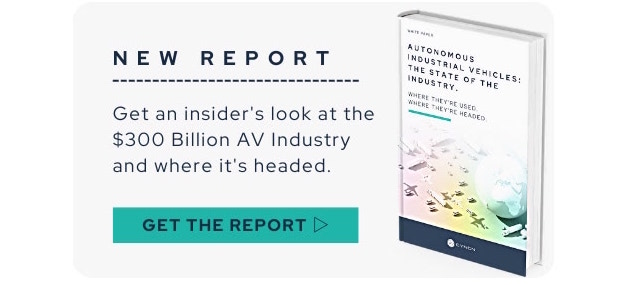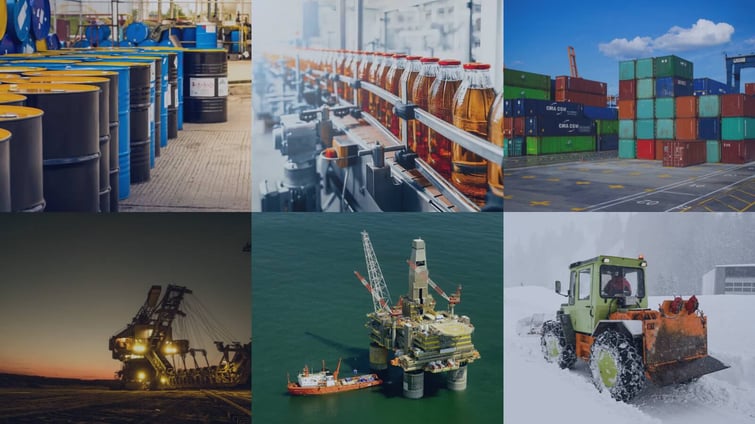While manufacturing has been identified as a key driver of growth for the industrial autonomy market, we have identified major industries currently employing and relying on industrial autonomy, which will also fuel AV industry growth. While the list is far too extensive to adequately represent, here are some key industries that are utilizing AV, driving growth, and furthering AV innovation:
Agriculture
The growing use of self-driving and IoT technology, such as autonomous tractors, in the agriculture industry has led to the terms Agriculture 4.0, Digital Farming, or Smart Farming, much in the way manufacturing is now experiencing Industry 4.0. Self-driving tractors take up the 8-12 hours/day of driving that used to be spent by humans. Vehicles are viewable, programmable and controllable via an app, and also offer considerable safety benefits.
An estimated 15% of US farmers are using IoT and self-driving tech on 250,000 farms. It is estimated that IoT and self-driving technology has the ability to advance productivity by up to 70% by 2050. This is critical, since it is estimated that food production must increase by 60% by 2050 due to population expansion. Agricultural robotics is estimated to grow from a $3 billion to $12 billion industry by 2026.
Aerospace
While autonomous flight may be a reality in our foreseeable future, the aerospace industry is currently using autonomous mobile robots for a wide variety of manufacturing uses, such as unloading trailers, warehouse transportation, tugger and trolley replacement, and pick-and-place. Rapid growth of utilization of autonomy is predicted, as a result of cost, labor, and time savings.
Construction
In addition to AVs for material transport, the use of autonomous bull dozers and excavators continues to grow. The global construction robotics market is expected to reach $7.9 billion by 2027, according to Allied Research.
Consumer Goods
Perhaps this topic warrants its own paper. In addition to warehouse and transportation robots, retailers are ramping up efforts for autonomous delivery vehicles, and are currently utilizing autonomous cleaning robots.
Chemicals
The chemical industry was an early-adopter of robotics and sensor technology, as safety is a major concern in chemical handling. AGVs are used to transport raw and finished materials, and to inspect hazardous or hard-to-reach areas, resulting in a safer, more productive operation.
Dairy
The dairy industry has been relying on a multitude of sensor technologies to monitor herd conditions as well as product. With labor accounting for more than 20% of production costs, the industry is now employing autonomous vehicles to roam pastures and monitor herd health and soil conditions, as well as autonomous grass harvesters and feeders.
Defense
The Defense industry uses autonomous vehicles for hazardous environments and unmanned scout missions, with both on and off-road capabilities. Unmanned Ground Vehicles (UGVs), also known as “Bots on the Ground”, are poised to not only impact, but even revolutionize land operations.
Food & Beverage
AVs have established themselves in food & beverage plants for material and product transport, as key benefits include reduced operational costs, faster ROI, reduced risk of spoilage, and reduced item damage.
Logistics and Supply Chain
Warehouse transport aside, the last-mile phase of delivery has historically been challenging. Retailers are looking to AVs to surmount this and other rifts in supply chains. With the use of robust 5G networks, natural language processing, sensor technology, and AI, AVs can bring reliability, speed and efficiency to last-mile delivery.
Mining
The Mining industry is an early adopter of autonomous dump trucks, drills, and vehicles to transport ore. As with other industries, the benefits of safer, productive, reliable multi-shift material transport are fundamental. Additionally, the move away from gas-powered vehicles provides a healthier environment for workers, with less need for ventilation.
Meat Processing
The meat industry is switching over from conventional forklifts to autonomous ones, which load AGVs that transport product across the plant to areas such as packaging, refrigeration, and loading docks. Considering the perishability of meat products, the efficiency that autonomy provides is a key consideration. In addition to warehouse transport applications, the meat (and other types of food) industry is using IoT sensors to monitor temperature during transport.
Metals
In sectors such as the aluminum industry, Hot Metal Carriers (HMCs), autonomously handle and transport tons of molten metal from the smelter to the casting shed, where it is then converted to block products. Smaller AVs then transport block products to other plant areas.
Oil & Gas
The Oil & Gas industry is currently utilizing autonomous drones, autonomous snakes, above ground AVs, and underwater autonomous vehicles for leak detection, pipe inspection, and security purposes.
Paper & Pulp
From forestry to pulp and paper production, AVs are being employed at every step of material transport in the paper industry.
Pharmaceuticals
Pharma is highly automated, from employing robots to fill and pack with high accuracy and efficiency, to using AVs to transport goods along manufacturing routes. Pharmaceutical companies have also begun using autonomous vehicles for product delivery.
Rescue
According to a report by Market Research Future, the Search and Rescue Robot market is projected to grow at a compound annual growth rate of 18.2% by 2027. Autonomous vehicles can traverse hazardous conditions, access hard-to-reach places, and send camera and sensor data to communicate findings with rescue workers.
Snow Removal
Driverless snow plows are already in use in countries such as Sweden and Canada. Minnesota is currently testing similar vehicles with advanced lane edge tracking in low-visibility, high-wind scenarios. California’s CALTRANS is in development of autonomous snow blowers for use on hazardous mountain roads.
Street Cleaning
Street Cleaning, a $1.9 Billion industry in the US, has begun development of fully autonomous, electric street sweeping robots, saving labor costs and reducing dependence on fossil fuels.
Transportation
Driverless trains, buses and shuttles, are in various stages of use and development, alongside advanced driver-assist and collision prevention technology. According to a report from Fortune Business Insights, the worldwide self-driving car market was estimated at $1.45 billion in 2020, and is forecasted to reach $11.03 billion by 2028.
This chaper is an excerpt from our industry report, Autonomous Industrial Vehicles: The State of the Industry. Access the full report here.

